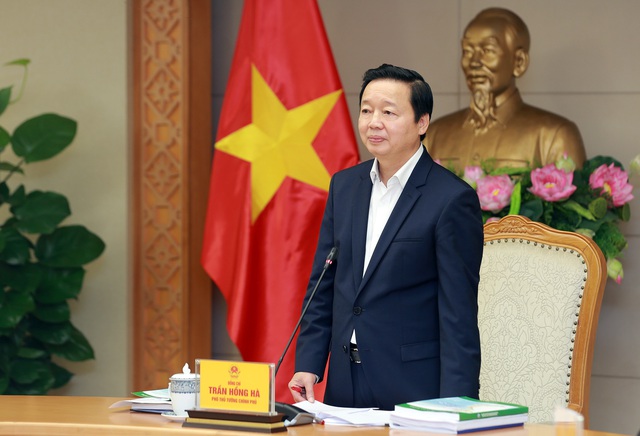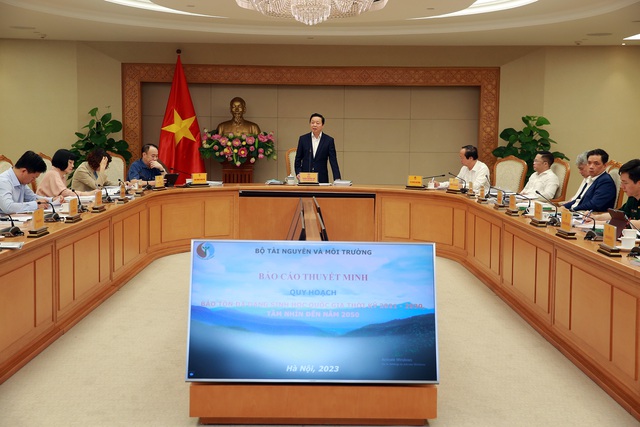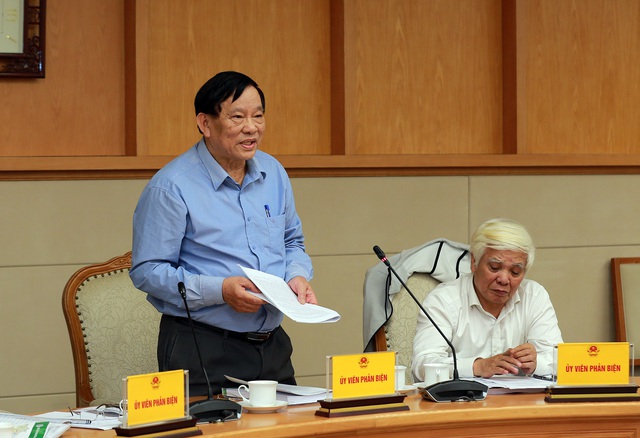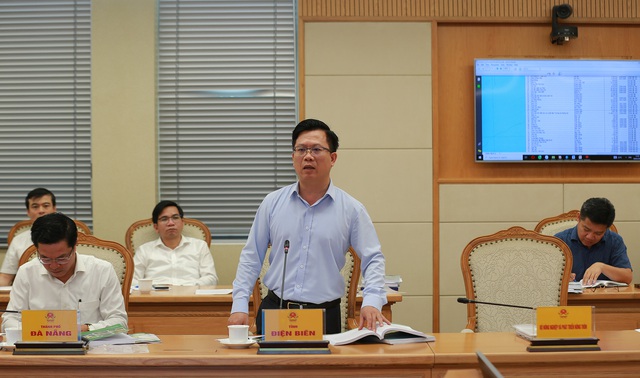Deputy Prime Minister Tran Hong Ha emphasized this point of view when chairing the meeting of the National Biodiversity Conservation Planning Appraisal Council for the period 2021-2030, vision to 2050 (Plan), on the morning of May 10 .

Deputy Prime Minister Tran Hong Ha said that the National Biodiversity Conservation Plan for the period 2021-2030, with a vision to 2050, must be approached from the perspective of “development based on conservation, conservation for development purposes.” ” – Photo: VGP/Minh Khoi
Conservation of biodiversity from the perspective of national planning
According to the Deputy Prime Minister, Vietnam has high biodiversity value, many endemic species are recognized by the world, and need to be preserved, exploited and used sustainably. In recent years, we have had many plans under different names to conserve, manage, and protect resources and biodiversity such as planning for nature reserves, wetlands, and heritage sites. nature of the region, the world…, however, the traditional economic development model is mainly based on natural resources and biodiversity.
Emphasizing that for the first time biodiversity conservation is being approached from the perspective of national planning, which is comprehensive and inclusive, the Deputy Prime Minister said that the Planning must ensure comprehensiveness, generality, both inheriting, integrating and resolving relationships with other laws and planning on: Environmental protection, forestry, fisheries, trading and transport of wild animal and plant products,…; At the same time, it demonstrates Vietnam’s responsibility for preserving biodiversity in the world; Update new thinking, perspectives, and goals on biological conservation in the world.

“The plan is setting the goal of preserving biodiversity of about 3 million hectares of land (9% of land area) and 3-5% of the natural area of national waters, but new conservation standards in the world The world believes that the proportion of land and ocean areas protected by biodiversity must be increased to 30%. Therefore, the way to handle the “problem” of biodiversity conservation in each country, including Vietnam, needs to be consistent with development requirements”, the Deputy Prime Minister gave an example and said that the Planning must truly meets development requirements, has a long-term vision, and is a tool to guide the policy of prioritizing investment in biodiversity conservation, from the perspective of “development based on conservation, conservation for the sake of conservation”. development goals”.
Many pressures on ecosystems and conservation areas
At the meeting, the Ministry of Natural Resources and Environment reported the results of implementing the master plan for biodiversity conservation of the country to 2020, with a vision to 2030 (Decision 45/QD-TTg dated August 8, 2020). January 2014).
Accordingly, by 2020, the whole country will have 178 conservation areas (national parks, nature reserves, species-habitat conservation areas, landscape protection areas) with an area of 2.66 million hectares; In the South Central region, 3 provincial-level biodiversity corridors have been established and managed with a total area of 298,146 hectares; discovered and recorded 43,500 types of animals on land and in water; 17,000 species of terrestrial and aquatic plants (not including 2,200 species of large fungi); The number of newly discovered species is constantly increasing; conserving 14,000 genetic resources of plants and animals…
Biodiversity conservation is currently under pressure from population changes that increase demand for resources; converting the use purpose of forest land and coastal land (lagoons, tidal flats) to serve economic development; The impact of environmental pollution and climate change…
Most natural ecosystems have been degraded or reduced in area. Wild species, especially the number of endangered species, are seriously reduced. Some livestock genetic resources have too few individuals.
Human, financial, and physical resources to implement biodiversity are limited.

Harmony between conservation and rational use of biodiversity resources
The National Biodiversity Conservation Plan for the period 2021-2030, with a vision to 2050, applies an ecosystem approach, integrating climate change content, forecasting change trends and needs. conserving biodiversity in the future…
The planning harmoniously combines conservation and reasonable use of biodiversity resources, in order to prevent and gradually reverse the decline and depletion of natural resources and biodiversity, and cope with change. climate; in situ conservation versus ex situ conservation; Strengthen biodiversity conservation outside of nature reserves; Minimize the destruction of natural ecosystems, change land use purposes in areas with protected natural ecosystems;… The plan also increases three biodiversity conservation objects, including: High biodiversity areas, important ecological landscapes and important wetlands.
The planning aims to: Increase the area, restore, ensure the integrity and connection of natural ecosystems; Effective conservation management of wild species and rare genetic resources; Build and develop a system of biodiversity conservation areas, high biodiversity areas, important ecological landscapes, and important wetlands to contribute to responding to climate change and sustainable development country.
Specifically, by 2030, the area of terrestrial protected areas will reach nearly 3 million hectares (equivalent to 9% of the land area), increasing the area of marine and coastal protected areas to reach 3%-5% of the natural area. national waters. The number of protected areas increased from 178 to 256 units, with promotion of wetland and marine protected areas. At the same time, establish facilities to raise endangered and rare species that need protection, and strengthen the capacity to rescue wild animals; Store and preserve endemic, endangered, rare and precious plant varieties, livestock, microorganisms and fungi that have special scientific, medical, economic, ecological, landscape, environmental or cultural value. chemistry-history…

Carefully evaluate the impact of the Plan on socio-economic growth
At the meeting, reviewers, members of the appraisal council, scientists, local representatives… continued to discuss frankly about the contents of the draft Planning: Scientific basis and thinking. , methodology, vision, solving the relationship between conservation and development, expanding concepts of conservation, natural ecological landscape values, natural reserves…
The comments also clarify the tasks, solutions, and implementation roadmap, as well as the direction to continue updating and developing the content of the Plan.
Prof. Dr. Nguyen Xuan Huan, Senior Lecturer at Hanoi National University, proposed the need to increase the area of conservation areas in areas of biodiversity and important ecosystems; Prioritize investment resources for newly established protected areas…
Mr. Vo Nguyen Chuong, Deputy Director of Da Nang Department of Natural Resources and Environment, said that carefully evaluating the impact of the Planning on socio-economic growth; Digitize data for localities to use when adjusting and updating synchronously with socio-economic development plans.
Given the fact that in places with a high rate of forest cover, people are very poor, Permanent Vice Chairman of Dien Bien Provincial People’s Committee Pham Duc Toan recommended that biodiversity conservation must be associated with creating livelihoods and improving biodiversity. living standards for local people, effectively exploiting the economic value brought by biodiversity, including the implementation of a substantive new Plan.

The Deputy Prime Minister emphasized the need to change perspectives and have new thinking in preserving, exploiting and using biodiversity resources, in harmony with socio-economic development – Photo: VGP/Minh Khoi
“Awakening” the value of landscape and biodiversity resources
Acknowledging the comments, Deputy Prime Minister Tran Hong Ha emphasized that this is a planning covering the national land territory and sea areas, so it is closely related to the national master plan and land planning. , marine planning as well as planning for agriculture, industry, environment, health care, fisheries, transportation, defense, security, local planning… Therefore, Planning must ensure synchronous, unified, without conflict or overlap with other plans.
The Deputy Prime Minister requested the Ministry of Natural Resources and Environment and the consulting unit to innovate the approach, perspective, and thinking of planning, which accurately determines the role and position of diverse resources. biology, methods of sustainable exploitation and use for socio-economic development, environmental protection, ecological balance, and ensuring a sustainable living environment. In particular, the Plan must evaluate the impact on socio-economic development and vice versa.
Emphasizing the viewpoint of “conservation for development, development based on conservation”, the Deputy Prime Minister said that the Planning needs to be “both static and dynamic” or “both closed and open”.
Firstly, the target group, specific tasks, and solutions have a solid legal basis and have been implemented in practice. The second is an open and flexible set of tools and criteria to determine the values of biodiversity resources in areas and ecosystems that need conservation, and at the same time serve economic development, associated with people’s livelihood.
The Deputy Prime Minister further analyzed: If conservation is simply cordoned off and kept unchanged, economic development will not be possible, whereas focusing only on economic development will not be able to preserve effectively. Therefore, the Planning must harmonize these two goals, in which conservation must change one step ahead, “awakening” the value of landscapes and biodiversity resources to fully manage, exploit and use them. , sustainable with ecological services that bring high economic efficiency.
“For ecosystems such as delta forests and coastal wetlands that are being degraded or degraded, there must be tools and criteria to determine and prove their economic and ecological value, and to respond to change. The climate is much higher than converting to agriculture, aquaculture, industrial parks… to preserve it,” the Deputy Prime Minister gave an example.
In urban areas there are forests, in forests there are urban areas
Deputy Prime Minister Tran Hong Ha also suggested major directions, perspectives, and new thinking on the management, exploitation, and sustainable use of biodiversity resources such as: In urban areas, there can also be conservation areas. such as forests, lakes, wetlands, in protected areas it is also possible to form urban areas, even in a building a complete ecosystem can be preserved…
“Only in this way can we combine biodiversity conservation with development and exploitation of green services, green economy, tourism…, conservation for humanity, aiming to meet new standards of diversity conservation. biology in the world,” Deputy Prime Minister said.
Along with receiving and fully explaining comments on the draft Planning, the Deputy Prime Minister assigned the Ministry of Natural Resources and Environment to fully and accurately update verified data and fully quote; applying information technology and digital transformation in managing interdisciplinary data layers on biodiversity conservation; Identify a number of priority projects to survey, investigate, and implement conservation associated with local socio-economic development…
Source Chinhphu.vn



